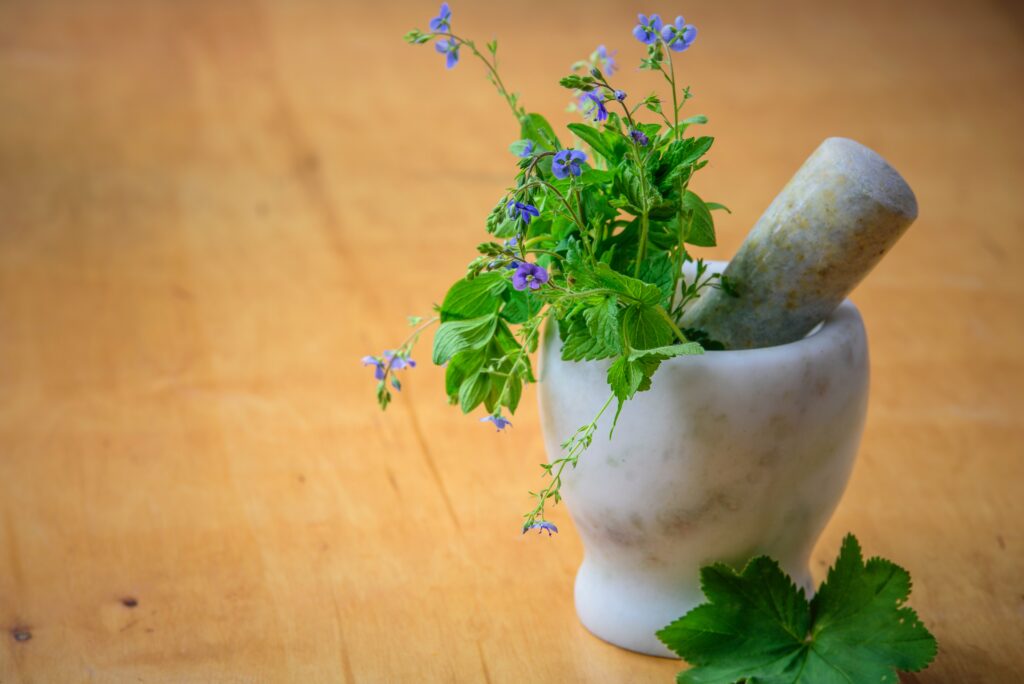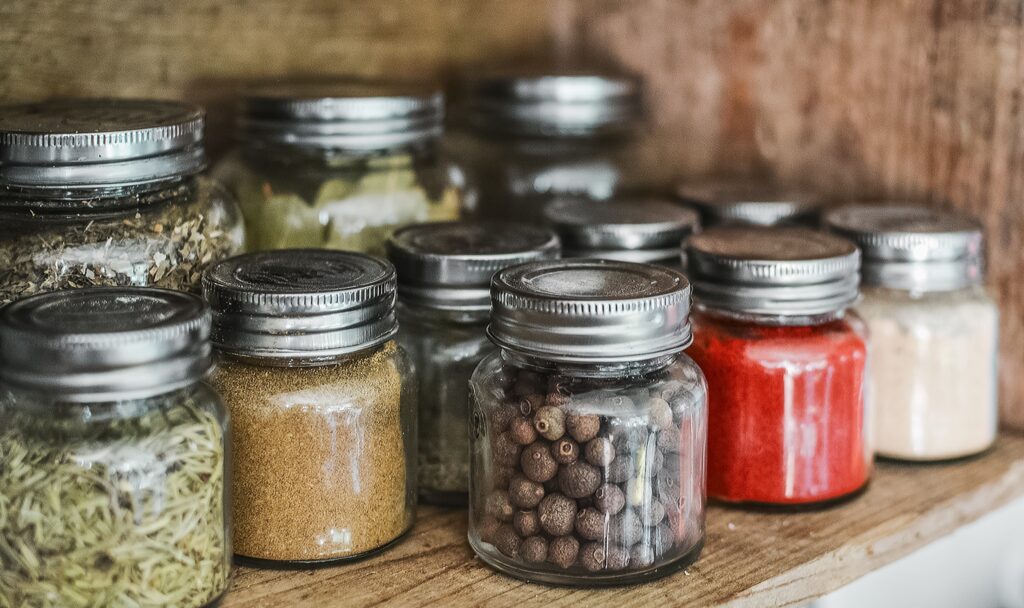Herbs are a great crop to grow in an aquaponic system because they don’t require a lot of space and have a high value-to-weight ratio. This means that you can grow a lot of herbs in a small space, and they will be relatively easy to maintain, sell or trade. Plus, herbs are versatile crops that can be used in various ways, from culinary to therapeutic and decoration purposes to any other reason. As you have already understood, in this blog post, you will find the best herbs for aquaponics, which to avoid and tips to grow them in an aquaponic environment.
Stay tuned until the end of this article to find everything you need to grow your herbs at home.
Can you Grow Herbs in Aquaponics?
Aquaponics is a type of gardening that combines fish and plants to create a symbiotic ecosystem. Fish waste delivers nutrients for the herb plants, and the herbs help to clean the fish’s water.
This gardening method is becoming increasingly popular as it is a more efficient way to grow plants and fish together.
But can you grow herbs in aquaponics?
The answer is yes! Herbs are one of the best plants to grow in aquaponics because they don’t require a lot of space or resources. They are relatively easy to care for and can thrive in various conditions.
So if you’re looking to add some fresh herbs to your aquaponics garden, try it by reading more about which herbs to choose below!
Benefits of Growing the best herbs for aquaponics

As everything in life has its benefits, so do herbs!
In this section of the article, we will explain why seeding herbs is a great choice for you and what advantages they offer you in case you decide to grow them at home.
As you already know, herbs have multiple uses and purposes for people, so let’s analyze them below.
Add flavour to your meals
Herbs are not only used for decoration because you can easily crop them when they are ready. Many people, especially chefs, use herbs to give their plates a nicer flavour or a better smell by dredging herbs like mint, oregano and cilantro.
If you haven’t tried it yet, this is another good reason to do it and remember that herbs will completely change your mind about the delicious taste of every plate by giving more flavour.
Save grocery costs
Many people buy herbs rather than grow them at home, forcing them to buy them from grocery stores.
Seeding your own herbs at home and in an aquaponic system will save you money because you will have your own herbs with almost no expenses. Also, if you are a big fan of herbs, this is probably the most important reason to start planting your own herbs at home today!
Healthy and organic
Herbs not only grow organically without fertilizers and technical modifications, but they are also very healthy if you have the habit of adding them to your meals, teas and more.
Some of them are also used for medical reasons as they include therapeutical ingredients like chamomile and ginger, which are usually used in teas as a tea flavour and offer the benefits of relieving stress and relaxing the human body.
Low maintenance
Growing your herbs at home and in an aquaponics system costs a few dollars because this system is sustainable and can grow, reproduce and maintain itself without much human effort or maintenance.
Apart from the fish tank, the fish and the seeds that you need to purchase to set up your aquaponic garden, there are no other expenses in the future which is like a one-time purchase for almost a lifetime.
Get experience
Seeding and growing your water garden at home gives you a great source of experience in order to improve your knowledge about aquaponics, harvesting and sustainability.
Many people just want to start this type of gardening instead of planting their herbs in their backyards to start a new hobby, try something they have never tried before and save extra costs on water consumption, fertilizers and avoid other wastes like packages and unsustainable items that people can not recycle.
How Fast do Herbs Grow in Aquaponic Systems?
Many people wonder how fast herbs can grow in aquaponics systems, so we decided to solve this question to let you know what is the appropriate time that herbs want to grow.
So, how fast do herbs grow in aquaponics systems? The answer depends on the type of herb and the conditions of the system.
In general, most herbs will grow relatively quickly in an aquaponics system. Some common herbs, such as basil and mint, can even be ready to harvest in as little as six weeks.
Moreover, it is important to mention that not all herbs grow together in the same amount of time because as we mentioned above, that depends on the conditions like the environment, temperature, the climate of the place you live and how much you maintain your aquaponics.
Are There Herbs that Can’t Grow in Aquaponics?
Generally speaking, there aren’t herbs that can not be grown in aquaponics systems. However, if there are some herbs that can not grow in that environment, it may be for various reasons that we will explain below.
There are very few herbs that can’t grow in aquaponics because almost any herb can grow in an aquaponic environment. If herbs can’t grow, it depends on other factors like the weather, the temperature, the climate or the season you decide to seed the herbs.
So if you’re looking to grow herbs in your aquaponics system, read below to find out which ones are the most interesting and useful to you.

Best Herbs for Aquaponics
The best herbs for aquaponics are those which can grow easily and without so much effort. These two facts are enough for you to decide which herbs are best for your water garden, so let’s find them below.
Here’s the list of the best herbs for aquaponics; you can choose as many as you want to start your aquaponic garden:
Basil: A Versatile Herb for Aquaponics
Basil, scientifically known as Ocimum basilicum, is an aromatic herb native to tropical regions of Asia. Its fragrant leaves and brilliant green color have made it popular for generations. Basil is an excellent herb to grow in aquaponics systems due to its adaptability and rapid growth.
Varieties of Basil
Basil comes in various varieties, each with its unique characteristics and flavors. Some popular basil varieties for aquaponics include:
- Sweet Basil: This is the most common type of basil with a sweet and slightly peppery flavor.
- Genovese Basil: Known for its large leaves and intense aroma, Genovese basil is a staple in Italian cuisine.
- Thai Basil: Thai basil tastes a lot like anise and is used a lot in Southeast Asian cooking.
- Lemon Basil: As the name suggests, lemon basil offers a refreshing citrusy twist to recipes.
- Purple Basil: With its striking purple leaves, purple basil adds visual interest to dishes and has a milder flavor compared to other varieties.
Cultivating Basil in Aquaponics
Basil is well-suited for aquaponics systems as it thrives in warm and humid environments. Here are some key considerations for growing basil:
- Planting: Basil can be started from seeds or transplants. Sow the seeds or transplant the seedlings into well-drained growing media.
- Light and Temperature: Basil requires at least six hours of direct sunlight each day. Maintain a temperature range of 70-90°F (21-32°C) for optimal growth.
- Water and Nutrients: Basil likes moisture but not waterlogging. It benefits from the nutrient-rich water in aquaponics systems.
- Pruning and Harvesting: Regular pruning promotes bushier growth, and harvesting the leaves encourages continual production.
Culinary Uses of Basil
Basil is a versatile herb that adds depth and aroma to numerous dishes. Its flavor pairs well with tomatoes, garlic, mozzarella cheese, and other complementary ingredients. Here are some popular culinary uses of basil:
- Caprese Salad: Basil leaves are a crucial component of the classic Caprese salad, alongside tomatoes, fresh mozzarella, and balsamic glaze.
- Pesto Sauce: The vibrant combination of basil, garlic, pine nuts, Parmesan cheese, and olive oil creates the famous pesto sauce used in pasta dishes, sandwiches, and more.
- Thai Cuisine: Thai basil is an essential ingredient in dishes like Pad Thai and Thai basil chicken, infusing them with its distinct flavor.
- Pizza Topping: Basil leaves are a popular topping for pizzas, adding a fresh and aromatic element to the flavor profile.
- Herbal Infusions: Basil leaves may flavor oils, vinegars, and water for dressings, marinades, and drinks.
- Soups and Sauces: Basil adds flavor and scent to tomato basil soup and other pasta sauces.
Health Benefits of Basil
In addition to its culinary uses, basil also offers several potential health benefits. While further research is needed, basil is believed to possess the following properties:
- Antioxidant Properties: Basil contains compounds, such as flavonoids and polyphenols, which may have antioxidant effects, helping to protect the body against oxidative stress.
- Anti-Inflammatory Effects: Some studies suggest that basil may possess anti-inflammatory properties that could potentially help reduce inflammation in the body.
- Rich in Essential Nutrients: Basil is a good source of vitamins A, K, and C, as well as minerals like calcium and magnesium, which contribute to overall health and well-being.
- Digestive Support: Basil aids digestion and may reduce bloating and indigestion.
Tips for Growing and Harvesting Basil
To ensure successful growth and bountiful harvests of basil in your aquaponics system, consider the following tips:
- Supportive Growing Conditions: Provide adequate sunlight, proper air circulation, and maintain the recommended temperature and humidity levels for basil.
- Pruning and Pinching: Regularly pinch off the tops of the basil plants to encourage branching and bushier growth. This will result in a higher yield of fresh leaves.
- Harvesting Basil Leaves: Harvest basil leaves by plucking them from the stem. Start harvesting when the plants have developed enough leaves, and continue to harvest regularly to promote continuous growth.
- Storing Fresh Basil: Store freshly harvested basil leaves in airtight containers or freeze them for future use. Alternatively, you can also dry the leaves for use as a dried herb.
Basil, with its diverse flavors and culinary versatility, is an ideal herb to cultivate in your aquaponics system. From traditional Italian dishes to Thai cuisine and beyond, basil adds a delightful aroma and taste to numerous recipes. With the right growing conditions and proper care, you can enjoy a steady supply of fresh basil leaves throughout the year.
Mint: A Refreshing Herb for Aquaponics
Mint is a versatile herb renowned for its invigorating aroma and cooling taste. With its lush green leaves and rapid growth, mint is a delightful addition to any aquaponics system. Whether used in culinary creations, herbal teas, or even homemade beauty products, mint brings a refreshing touch to various aspects of our lives.
Varieties of Mint
There are several popular mint varieties that can be grown in aquaponics systems. Some common types of mint include:
- Spearmint: Spearmint is one of the most popular mint varieties with its refreshing, slightly sweet flavor. It’s commonly used in beverages, desserts, and Middle Eastern cuisine.
- Peppermint: Peppermint has a stronger flavor compared to spearmint, with a cooling sensation. It’s often used in herbal teas, candies, and as a flavoring agent in many culinary preparations.
- Chocolate Mint: Chocolate mint offers a unique twist with its subtle chocolatey undertones. It can be used in desserts, hot beverages, or as a decorative garnish.
- Orange Mint: With its citrusy aroma and taste, orange mint adds a refreshing element to beverages, salads, and desserts.
- Apple Mint: Apple mint has a hint of apple fragrance, making it a delightful addition to fruit salads, beverages, and cocktails.
Growing Mint in Aquaponics
Mint is an excellent choice for aquaponics systems due to its adaptability and vigorous growth. Here are some key considerations when growing mint:
- Planting Mint: Mint can be grown from seeds, cuttings, or transplants. Ensure each mint plant has enough space to spread its roots.
- Light and Temperature: Mint thrives in partial shade to full sun, so place your aquaponics system where it can receive at least 4-6 hours of direct sunlight each day. Maintain a temperature range of 60-75°F (15-24°C).
- Water and Nutrients: Mint prefers consistently moist soil but not waterlogged conditions. The nutrient-rich water in aquaponics systems provides an ideal growing environment for mint.
- Containment: Mint is invasive, so cultivate it in pots or grow beds to keep it from taking over.
Culinary Uses of Mint
Mint’s fresh and uplifting flavor adds a delightful touch to a variety of culinary creations. Here are some popular culinary uses of mint:
- Beverages: Mojitos, mint juleps, and flavored water or lemonade use mint. It adds flavor to drinks, iced teas, and smoothies.
- Salads and Dressings: Mint leaves can be chopped and added to salads, imparting a refreshing element to the dish. It pairs well with fruits, such as watermelon or berries, and complements savory salads like tabbouleh. Mint-infused dressings can also elevate the flavor profile of your salads.
- Desserts: Mint is often used in desserts, such as mint chocolate chip ice cream, mint-flavored cakes and cookies, and mint-infused syrups for drizzling over desserts or fruit salads.
- Savory Dishes: Mint leaves can be used in savory dishes like curries, stir-fries, and roasted vegetables, adding a bright and aromatic touch to the flavors.
Medicinal and Therapeutic Benefits of Mint
Mint has a long history of use in traditional medicine for its potential health benefits. While further research is needed, mint is believed to offer several medicinal and therapeutic properties, including:
- Digestive Aid: Mint is known for its soothing effects on the digestive system. It may help alleviate symptoms such as indigestion, bloating, and stomach discomfort.
- Respiratory Support: The menthol compound present in mint leaves can provide a cooling sensation and potentially help relieve congestion, coughs, and respiratory discomfort.
- Mood Enhancer: Mint’s refreshing aroma is often associated with a calming and uplifting effect, making it a popular ingredient in aromatherapy and relaxation practices.
- Oral Health: Mint is commonly used in oral care products due to its natural antibacterial properties. It may help freshen breath and promote oral hygiene.
Tips for Growing and Harvesting Mint
To ensure successful growth and bountiful harvests of mint in your aquaponics system, consider the following tips:
- Containment: Due to its invasive nature, it’s best to grow mint in containers or separate grow beds to prevent it from spreading and dominating the space.
- Regular Pruning: Prune mint regularly to encourage bushier growth and prevent it from becoming leggy. Pinch off the tips of the stems to promote branching and the emergence of fresh leaves.
- Harvesting Mint Leaves: Harvest mint leaves by cutting the stems just above a leaf node. This will encourage new growth and ensure a continuous supply of fresh leaves. Harvest in the morning when the flavor is at its strongest.
- Storing Fresh Mint: To store fresh mint leaves, wrap them loosely in a damp paper towel and place them in a plastic bag or airtight container. Store in the refrigerator and use within a few days for the best flavor.
Mint is a versatile and refreshing herb that thrives in aquaponics systems. Its invigorating aroma and cooling taste make it a valuable addition to culinary creations, beverages, and even homemade remedies. With proper care and attention, you can enjoy a steady supply of fresh mint leaves straight from your aquaponics garden.
Parsley: A Nutritious Herb for Aquaponics
Parsley is a versatile herb known for its vibrant green leaves and distinct flavor. It is a popular ingredient in culinary dishes worldwide and adds a fresh, aromatic touch to various recipes. Apart from its culinary uses, parsley is also a nutrient-rich herb with potential health benefits. Growing parsley in your aquaponics system can provide you with a continuous supply of this nutritious herb.
Parsley—Petroselinum crispum—is a biennial herb used in cooking and medicinal. It has been grown throughout the Mediterranean for generations. Parsley adds color, taste, and scent to aquaponics systems.
Varieties of Parsley
There are two main varieties of parsley commonly grown:
- Flat-Leaf Parsley: Also known as Italian parsley, flat-leaf parsley has flat, serrated leaves and a robust flavor. It’s often preferred in cooking due to its stronger taste and versatility.
- Curly Parsley: Curly parsley has tightly curled, decorative leaves and a milder flavor compared to flat-leaf parsley. It’s commonly used as a garnish or for visual appeal in dishes.
Growing Parsley in Aquaponics
Parsley is relatively easy to grow in aquaponics systems and can thrive with the right conditions. Here are some key considerations when growing parsley:
- Planting Parsley: Parsley can be grown from seeds or transplants. Sow the seeds directly into the growing media or start them in seed trays for later transplantation.
- Light and Temperature: Parsley prefers partial shade to full sun, so ensure your aquaponics system receives at least 4-6 hours of direct sunlight each day. Maintain a temperature range of 60-80°F (15-27°C) for optimal growth.
- Water and Nutrients: Parsley requires consistently moist soil. The nutrient-rich water in aquaponics systems provides a suitable environment for parsley to thrive.
- Spacing and Pruning: Allow enough space between parsley plants to encourage air circulation and prevent overcrowding. Regular pruning helps promote bushier growth and prolongs the harvest season.
Culinary Uses of Parsley
Parsley is a versatile herb that enhances the flavor and appearance of various culinary dishes. It is often used as a garnish and can also be incorporated into recipes in the following ways:
- Flavorful Additions: Chopped parsley leaves give fresh, herbaceous taste to salads, soups, stews, sauces, and marinades.
- Herb Butter and Seasonings: Herb-infused butter or oil may flavor vegetables, pasta, bread, and shellfish.
- Parsley Pesto: A tasty pesto sauce may be made with parsley. Simply blend parsley leaves with garlic, nuts, Parmesan cheese, and olive oil for a delicious twist on the classic basil pesto.
- Tabbouleh Salad: Parsley is a key ingredient in tabbouleh, a popular Middle Eastern salad. Combined with bulgur wheat, tomatoes, onions, and lemon juice, parsley adds freshness and a distinctive taste to this refreshing dish.
- Herbaceous Dressings: Parsley may flavor salads and vegetables with homemade dressings and vinaigrettes.
Health Benefits of Parsley
In addition to its culinary uses, parsley offers a range of potential health benefits due to its nutrient content. While further research is needed, parsley is believed to possess the following properties:
- Rich in Antioxidants: Parsley is a good source of antioxidants, including vitamin C, beta-carotene, and flavonoids. These compounds help protect the body against oxidative stress and support overall well-being.
- Nutrient-Dense: Parsley is packed with essential vitamins and minerals, such as vitamin K, vitamin A, vitamin C, folate, and iron. These nutrients contribute to bone health, immune function, and red blood cell production.
- Digestive Support: Parsley contains compounds that may aid digestion and promote a healthy digestive system. It is often used as a natural remedy for bloating and indigestion.
- Potential Anti-Inflammatory Effects: Some studies suggest that parsley may possess anti-inflammatory properties, which could be beneficial for reducing inflammation in the body.
Tips for Growing and Harvesting Parsley
To ensure successful growth and abundant harvests of parsley in your aquaponics system, consider the following tips:
- Start from Seeds: Parsley seeds can be directly sown into the growing media of your aquaponics system. Soak the seeds in warm water for a few hours before planting to improve germination.
- Provide Adequate Water: Parsley prefers consistently moist soil, so ensure your aquaponics system maintains a proper balance of water and allows for good drainage. Avoid overwatering. It causes root rot.
- Regular Harvesting: Harvest parsley leaves regularly by snipping them from the outer stems, leaving the inner leaves to continue growing. Regular harvesting encourages new growth and prolongs the harvest season.
- Storing Fresh Parsley: Place freshly harvested parsley stems in a glass of water and store it in the refrigerator, covering the leaves loosely with a plastic bag. This helps to keep the parsley fresh for several days.
Parsley is a versatile and nutritious herb that adds flavor, freshness, and visual appeal to culinary dishes. Its adaptability makes it an ideal choice for growing in aquaponics systems, providing a continuous supply of this vibrant herb. From garnishes to sauces, salads to pesto, parsley offers a wide range of culinary possibilities.
Oregano: A Flavorful Herb for Aquaponics
Oregano is a fragrant and flavorful herb that adds a delightful touch to various culinary dishes. With its robust aroma and distinct taste, oregano is a popular herb in Mediterranean, Italian, and Mexican cuisines. Growing oregano in your aquaponics system allows you to have a steady supply of this versatile herb right at your fingertips.
Oregano, scientifically known as Origanum vulgare, is a perennial herb belonging to the mint family. It is native to the Mediterranean region and has been used for centuries for its aromatic and medicinal properties. Oregano is known for its small leaves, which are packed with intense flavor and fragrance.
Varieties of Oregano
There are several varieties of oregano that can be grown in aquaponics systems. Some common types of oregano include:
- Greek Oregano: Also known as true oregano or Origanum vulgare subsp. hirtum, Greek oregano has a strong flavor and is commonly used in Mediterranean and Greek cuisines.
- Italian Oregano: Italian oregano, or Origanum x majoricum, has a milder flavor compared to Greek oregano. It is often used in Italian dishes, such as pasta sauces, pizzas, and herb-infused oils.
- Mexican Oregano: Mexican oregano, scientifically known as Lippia graveolens, has a distinct flavor profile with citrusy and earthy notes. It is frequently used in Mexican and Tex-Mex cuisines.
Growing Oregano in Aquaponics
Oregano is a hardy herb that is well-suited for aquaponics systems. Here are some key considerations when growing oregano:
- Planting Oregano: Oregano may be started from either seeds or cuttings, and it can also be grown from transplants. Sow the seeds directly into the growing media or start them in seed trays before transplanting.
- Light and Temperature: Oregano thrives in full sun, so place your aquaponics system in a location where it can receive at least 6-8 hours of direct sunlight per day. Maintain a temperature range of 60-80°F (15-27°C) for optimal growth.
- Water and Nutrients: Oregano prefers well-drained soil and moderate watering. In aquaponics systems, the nutrient-rich water provides the ideal growing conditions for oregano.
- Pruning and Maintenance: Regular pruning helps promote bushier growth and prevents oregano from becoming leggy. Pinch off the tips of the stems to encourage branching and the emergence of fresh leaves.
Culinary Uses of Oregano
Oregano is widely used in culinary preparations for its robust flavor and aromatic qualities.
- Italian Cuisine: Oregano is a staple herb in Italian cuisine, particularly in dishes like pasta sauces, pizzas, and marinades. Its distinct flavor complements tomato-based sauces and adds depth to various Italian recipes.
- Mediterranean Dishes: Oregano is an essential herb in Mediterranean cooking. It pairs well with olive oil, lemon, garlic, and other Mediterranean ingredients. Use it in Greek salads, roasted vegetables, grilled meats, and more.
- Mexican and Tex-Mex Cuisine: Mexican oregano is commonly used in Mexican and Tex-Mex dishes. It enhances the flavors of salsas, tacos, enchiladas, and chili con carne. Its citrusy notes add a unique twist to these spicy dishes.
- Herb-Infused Oils and Vinegars: Oregano can be infused into oils and vinegars to create flavorful dressings, marinades, and dipping sauces. Simply combine oregano leaves with the desired oil or vinegar and let it infuse for a few days before using.
- Seasoning Blends: Oregano is a key ingredient in various seasoning blends, such as Italian seasoning, Herbes de Provence, and za’atar. These blends add complexity and depth of flavor to a wide range of dishes.
Medicinal Benefits of Oregano
Apart from its culinary uses, oregano has been valued for its potential medicinal benefits. While further research is needed, oregano is believed to possess the following properties:
- Antioxidant Properties: Oregano contains compounds that act as antioxidants, helping to protect the body against oxidative stress and damage caused by free radicals.
- Antimicrobial and Antibacterial Effects: Oregano has antimicrobial properties due to the presence of compounds like carvacrol and thymol. It may help combat certain bacteria and fungi.
- Digestive Aid: Oregano has been traditionally used to support digestion. It may help alleviate digestive discomfort and promote healthy digestion.
- Potential Anti-inflammatory Effects: Some studies suggest that oregano may have anti-inflammatory properties, which could be beneficial for reducing inflammation in the body.
Tips for Growing and Harvesting Oregano
To ensure successful growth and abundant harvests of oregano in your aquaponics system, consider the following tips:
- Starting from Seeds or Cuttings: Oregano grows from seeds or cuttings. If using seeds, sow them directly into the growing media. For cuttings, take 4-6 inch (10-15 cm) stem cuttings and plant them in the growing media.
- Light and Temperature: Provide oregano plants with ample sunlight, ideally 6-8 hours of direct sunlight per day. Oregano thrives in temperatures between 60-80°F (15-27°C).
- Watering and Drainage: Oregano prefers well-drained soil. Water the plants when the top layer of soil feels dry, but avoid overwatering. It causes root rot.
- Harvesting Leaves: Harvest oregano leaves once the plant has established itself. Snip off the outer stems, leaving the inner leaves to continue growing. Regular harvesting encourages bushier growth.
- Drying and Storing Oregano: To preserve oregano, hang the harvested stems upside down in a well-ventilated area until the leaves are completely dry. Leaves should be stored in a dark, airtight container.
Oregano is a versatile and flavorful herb that brings a distinctive taste to a wide range of culinary dishes. Whether used in Italian, Mediterranean, or Mexican cuisine, oregano adds a delightful aromatic touch that enhances the overall flavor profile of the food. By growing oregano in your aquaponics system, you can have a fresh and abundant supply of this herb throughout the year.
In addition to its culinary benefits, oregano also offers potential health benefits due to its antioxidant and antimicrobial properties. While it is not a substitute for medical treatment, incorporating oregano into your diet can be a flavorful way to support overall well-being.
Thyme: A Fragrant Herb for Aquaponics
Thyme is a versatile herb known for its delightful fragrance and culinary uses. It is a popular herb in Mediterranean and European cuisines, adding a unique flavor and aroma to various dishes. Growing thyme in your aquaponics system allows you to have a steady supply of this aromatic herb right at your fingertips.
Thyme, scientifically known as Thymus vulgaris, is a small perennial herb with fragrant leaves and a woody stem. It belongs to the mint family and is native to the Mediterranean region. Thyme has been used for centuries in culinary and medicinal applications.
Varieties of Thyme
There are several varieties of thyme that can be grown in aquaponics systems. Some common types of thyme include:
- Common Thyme: Also known as English thyme, common thyme is the most widely grown variety. It has a strong, earthy flavor and is commonly used in a variety of dishes.
- Lemon Thyme: Lemon thyme has a citrusy aroma and flavor, making it a popular choice for seafood, poultry, and vegetable dishes. It adds a bright and refreshing touch to culinary creations.
- Creeping Thyme: Creeping thyme is a low-growing variety that forms a dense ground cover. It’s utilized in landscaping and cooking.
Growing Thyme in Aquaponics
Thyme is a hardy herb that thrives in aquaponics systems. Here are some key considerations when growing thyme:
- Planting Thyme: Thyme can be grown from seeds, cuttings, or transplants. Sow the seeds directly into the growing media or start them in seed trays before transplanting. Alternatively, take stem cuttings from an existing thyme plant and root them in a rooting medium.
- Light and Temperature: Thyme requires full sun to partial shade, so place your aquaponics system in a location where it can receive at least 6-8 hours of direct sunlight per day. Thyme prefers a temperature range of 60-80°F (15-27°C).
- Water and Nutrients: Thyme prefers well-drained soil and moderate watering. In aquaponics systems, the nutrient-rich water provides an ideal growing environment for thyme.
- Pruning and Maintenance: Regular pruning helps promote bushier growth and prevents thyme from becoming leggy. Trim the stems regularly to encourage new growth and maintain a compact shape.
Culinary Uses of Thyme
Thyme is a versatile herb that adds depth and flavor to various culinary dishes. Its aromatic and earthy taste complements a wide range of ingredients. Here are some popular culinary uses of thyme:
- Soups and Stews: Thyme is a common ingredient in soups and stews, adding a savory and herbaceous flavor. It pairs well with vegetables, beans, and meats like chicken, beef, and lamb.
- Roasted Meats and Poultry: Thyme enhances the taste of roasted meats and poultry, imparting a delicious herbal note. Rub thyme leaves onto the meat before roasting, or add sprigs of thyme to the roasting pan for extra flavor.
- Sauces and Marinades: Thyme-infused sauces and marinades add depth and complexity to dishes. It blends well with other herbs like rosemary and sage, creating a harmonious flavor profile.
- Vegetable Dishes: Thyme complements a variety of vegetables, including roasted potatoes, sautéed mushrooms, grilled zucchini, and oven-baked tomatoes. Its earthy flavor balances the sweetness of vegetables.
- Breads and Pastries: Thyme adds flavor and perfume to bread dough. It also pairs well with butter or olive oil as a spread for bread or crackers. In pastries, thyme adds a unique twist to desserts like lemon-thyme shortbread cookies.
- Infused Oils and Vinegars: Create infused oils and vinegars by steeping fresh thyme sprigs in olive oil or vinegar. These infused liquids add flavor to sauces, marinades, and salads.
- Herb Blends: Thyme is a key ingredient in various herb blends, such as Herbes de Provence or bouquet garni. These mixes season sauces, roasted meats, and vegetables.
Growing Thyme in Aquaponics
To successfully grow thyme in your aquaponics system, follow these steps:
- Starting from Seeds: Begin by planting thyme seeds in a seed tray filled with a well-draining growing medium. Keep the tray in a warm and well-lit area until the seeds germinate.
- Transplanting Seedlings: Once the seedlings have developed a couple of sets of true leaves, carefully transplant them into your aquaponics system, ensuring they have enough space to grow.
- Light and Temperature: Thyme thrives in full sunlight, so place your aquaponics setup in a sunny location. Maintain a temperature range of 60-80°F (15-27°C) for optimal growth.
- Water and Nutrients: Thyme prefers well-drained soil, so ensure your aquaponics system provides adequate drainage. Monitor the water pH and nutrient levels to ensure they are within the appropriate range for thyme cultivation.
- Pruning and Harvesting: Regularly prune your thyme plants to promote bushier growth and increase yield. Harvest the leaves as needed, and remember that fresh thyme leaves have the most robust flavor.
Health Benefits of Thyme
In addition to its culinary uses, thyme also offers several health benefits. This fragrant herb is rich in essential nutrients and bioactive compounds that can support overall well-being. Here are some notable health benefits of thyme:
- Antioxidant Properties: Thyme contains high levels of antioxidants, including phenolic compounds like thymol and rosmarinic acid. Antioxidants prevent oxidative stress and chronic illnesses.
- Anti-inflammatory Effects: Thyme possesses anti-inflammatory properties that can help reduce inflammation in the body. This can be beneficial for conditions such as arthritis, respiratory issues, and inflammatory bowel disease.
- Digestive Support: Thyme aids digestion and relieves stomach pain. It can help stimulate the production of digestive enzymes, promote healthy gut function, and relieve symptoms such as bloating and indigestion.
- Respiratory Health: Thyme has expectorant and antitussive properties, making it beneficial for respiratory health. It can help soothe coughs, relieve congestion, and promote healthy breathing. Thyme-infused teas or steam inhalation can be effective for respiratory issues.
- Immune System Boost: The bioactive compounds in thyme, including vitamin C and other antioxidants, can support a healthy immune system. Thyme’s antimicrobial properties may also help combat certain infections.
- Heart Health: Thyme contains compounds that can support heart health. It may help lower blood pressure, reduce cholesterol levels, and improve blood circulation, thereby reducing the risk of cardiovascular diseases.
- Cognitive Function: Some studies suggest that thyme may have cognitive benefits. Memory, attention, and concentration may improve. The antioxidants in thyme can also protect against age-related cognitive decline.
- Skin Health: Thyme possesses antimicrobial and anti-inflammatory properties, making it beneficial for skin health. It can help treat acne, soothe skin irritations, and promote a clear and healthy complexion.
Rosemary: An Aromatic Herb for Aquaponics
Rosemary (Rosmarinus officinalis) is an aromatic herb that offers a multitude of benefits, making it an excellent choice for aquaponics systems. With its distinct fragrance, culinary versatility, and potential health benefits, rosemary adds value to any aquaponics garden. In this article, we will explore the art of growing rosemary in aquaponics, its culinary uses, and the potential health benefits it provides.
Growing Tips for Rosemary in Aquaponics
Rosemary can thrive in aquaponics systems with the right conditions. Tips for good growth:
- Optimal Temperature: Rosemary prefers moderate to warm temperatures, ideally between 65°F and 85°F (18°C to 29°C). Ensure the water temperature in your aquaponics system remains within this range.
- Lighting Requirements: Rosemary requires plenty of sunlight to thrive. Get six hours of direct sunshine daily. If your system lacks natural sunlight, supplement it with full-spectrum grow lights.
- pH and Nutrient Levels: Rosemary prefers slightly acidic to neutral pH levels, ranging from 6.0 to 7.5. Regularly monitor and adjust the pH of your aquaponics system to provide an optimal environment for rosemary’s growth.
- Well-Drained Growing Medium: Rosemary thrives in well-draining media, such as a mixture of perlite and coco coir. Prevents waterlogging and root rot.
- Pruning and Harvesting: Regular pruning is crucial to maintain the shape and encourage new growth. Harvest rosemary by cutting the stems above a leaf node, promoting bushy growth and ensuring a continuous supply of fresh herbs.
Culinary Uses of Rosemary
Rosemary’s unique flavor profile makes it a beloved herb in the culinary world. Here are some popular culinary uses of rosemary:
- Roasted Meats: Rosemary pairs exceptionally well with roasted meats, such as lamb, chicken, and beef. Sprinkle chopped rosemary leaves over the meat before cooking to infuse it with a delightful aroma and flavor.
- Vegetable Dishes: Add a touch of rosemary to roasted or grilled vegetables to elevate their taste. It complements potatoes, carrots, zucchini, and more, enhancing their natural flavors.
- Marinades and Dressings: Infuse marinades and dressings with rosemary to impart a distinct herbal note. Combine it with olive oil, lemon juice, garlic, and other herbs for a flavorful blend.
- Breads and Baked Goods: Rosemary adds a delightful twist to bread and baked goods. Incorporate chopped rosemary into bread dough or sprinkle it over focaccia for a fragrant and savory experience.
Health Benefits of Rosemary
Beyond its culinary appeal, rosemary offers potential health benefits. While further research is needed, here are some reported benefits associated with rosemary:
- Antioxidant Properties: Rosemary contains compounds with antioxidant properties that help combat free radicals and oxidative stress in the body.
- Anti-Inflammatory Effects: Certain compounds in rosemary, such as rosmarinic acid, exhibit anti-inflammatory properties that may help reduce inflammation in the body.
- Cognitive Function: Rosemary boosts memory and focus. Its scent may stimulate the brain.
- Digestive Support: Rosemary has been used for digestive issues, including indigestion and bloating. It may help stimulate digestion and relieve gastrointestinal discomfort.
Incorporating rosemary into your aquaponics system can be a rewarding experience. This aromatic herb not only adds a delightful fragrance to your garden but also offers versatile culinary uses and potential health benefits. With proper care and attention to its growing requirements, rosemary can thrive in aquaponics, providing you with a continuous supply of fresh, flavorful herbs.
Cilantro: A Flavorful Herb for Aquaponics
Cilantro, also known as coriander or Chinese parsley, is a flavorful herb that adds a unique zest to dishes. Its vibrant green leaves and distinctive aroma make it a popular choice for aquaponics systems. In this article, we will explore the art of growing cilantro in aquaponics, its culinary versatility, potential health benefits, and the joy it brings to your gardening experience.
Growing Tips for Cilantro in Aquaponics
Cilantro can be a rewarding herb to grow in your aquaponics system. Consider the following tips to ensure successful growth:
- Optimal Temperature: Cilantro prefers cool to moderate temperatures, ideally between 50°F and 85°F (10°C to 29°C). Provide adequate ventilation in warmer climates to prevent the herb from bolting.
- Light Requirements: Cilantro thrives in partial shade to full sun. Ensure your aquaponics setup receives at least four to six hours of sunlight per day. Supplemental grow lights can be used if natural sunlight is limited.
- Moisture and Watering: Cilantro prefers consistently moist soil. Ensure your aquaponics system provides sufficient water to keep the soil evenly moist. Avoid overwatering. It causes root rot.
- Proper Spacing: Cilantro plants benefit from adequate spacing to promote airflow and reduce the risk of diseases. Plant them 6 to 8 inches (15 to 20 cm) apart to allow for healthy growth.
- Succession Planting: Cilantro has a relatively short lifespan before it bolts and goes to seed. To ensure a continuous supply of cilantro, consider succession planting by sowing new seeds every few weeks.
Culinary Uses of Cilantro
Cilantro is widely used in various culinary traditions around the world. Here are some popular culinary uses of cilantro:
- Flavorful Herb in Salads: Cilantro adds a refreshing and tangy flavor to salads. Chop the leaves and sprinkle them over mixed greens or use them as a garnish for vibrant color and taste.
- Essential Ingredient in Salsas and Dips: Cilantro is a key ingredient in many salsas, chutneys, and dips. Its bright flavor pairs well with tomatoes, onions, lime juice, and other complementary ingredients.
- Herbaceous Addition to Asian Cuisine: Asian curries, pho, and chutneys use cilantro. Its aromatic qualities enhance the complex flavors of these cuisines.
- Seasoning for Soups and Stews: Add cilantro leaves to soups and stews during the last few minutes of cooking to infuse them with a fresh and herbaceous taste.
Health Benefits of Cilantro
Beyond its culinary appeal, cilantro offers potential health benefits.
- Nutrient Rich: Cilantro is a good source of vitamins A, C, and K, as well as minerals like potassium and manganese. Including cilantro in your diet adds nutritional value to your meals.
- Digestive Support: Cilantro has been traditionally used to support digestion and alleviate digestive discomfort. It may help stimulate enzymes and promote healthy digestion.
- Antioxidant Properties: Cilantro contains antioxidants that help combat oxidative stress and protect against cellular damage.
- Detoxification Support: Some studies suggest that cilantro may help remove heavy metals from the body, acting as a natural detoxification agent.
Cilantro is a flavorful herb that brings zest and vibrancy to dishes, making it a valuable addition to any aquaponics system. By following the proper growing tips and maintaining the right conditions, you can enjoy a continuous supply of fresh cilantro in your aquaponics garden.
Moreover, cilantro offers potential health benefits, including its nutrient content, support for digestion, antioxidant properties, and potential detoxification support.
Dill: A Herb with Unique Flavor for Aquaponic
Dill is a versatile herb known for its unique flavor and fragrance. It is a popular choice for aquaponics systems due to its easy cultivation and the delightful taste it adds to dishes. In this article, we will explore the art of growing dill in aquaponics, its culinary versatility, potential health benefits, and the joy it brings to your gardening and culinary experience.
Growing Tips for Dill in Aquaponics
Dill is a relatively low-maintenance herb to grow in your aquaponics system. Consider the following tips for successful cultivation:
- Optimal Temperature: Dill thrives in moderate temperatures, ideally between 60°F and 70°F (15°C to 21°C). Ensure your aquaponics setup provides the appropriate temperature range for optimal growth.
- Light Requirements: Dill prefers full sun to partial shade. Provide at least six to eight hours of sunlight per day or use supplemental grow lights to ensure sufficient light for the plants.
- Soil and Watering: Dill prefers well-drained soil with consistent moisture. Ensure your aquaponics system provides adequate water to keep the soil evenly moist, but avoid overwatering. It causes root rot.
- Spacing: Allow sufficient spacing between dill plants to promote healthy growth and airflow. Plant them 12 to 18 inches (30 to 45 cm) apart to avoid overcrowding.
- Harvesting: Harvest dill leaves when they are young and tender for the best flavor. Trim the leaves as needed, leaving the main stem intact to encourage continuous growth.
Culinary Uses of Dill
Dill is widely used in various culinary traditions around the world. Here are some popular culinary uses of dill:
- Flavoring for Seafood and Fish: Dill pairs exceptionally well with seafood and fish dishes. Its fresh and slightly tangy flavor complements the delicate taste of these proteins.
- Pickling and Preserving: Pickled cucumbers and other vegetables utilize dill. Its distinctive flavor infuses the pickling brine, adding a unique twist to preserved foods.
- Culinary Garnish: Sprinkle fresh dill leaves over salads, soups, and roasted vegetables to add a pop of flavor and visual appeal. Dill also makes a beautiful garnish for various dishes.
- Seasoning for Sauces and Dressings: Add chopped dill to sauces, dressings, and dips to enhance their flavor profiles. Dill works well in creamy dressings, yogurt-based sauces, and herb-infused oils.
Health Benefits of Dill
Dill not only adds flavor to dishes but may also offer potential health benefits. While further research is needed, here are some reported benefits associated with dill:
- Digestive Support: Dill aids digestion and soothes stomach aches. It may help soothe the stomach and reduce bloating and indigestion.
- Antioxidant Properties: Dill contains antioxidants that help neutralize harmful free radicals in the body, contributing to overall health and well-being.
- Potential Anti-inflammatory Effects: Some compounds found in dill have shown anti-inflammatory properties in preliminary studies. These properties may have potential benefits for reducing inflammation in the body.
- Nutrient Content: Dill is a good source of vitamins A and C, as well as minerals like calcium and iron. Incorporating dill into your diet adds nutritional value to your meals.
Dill is a delightful herb that brings a unique flavor and fragrance to dishes, making it a valuable addition to any aquaponics system. By following the proper growing tips and providing the right conditions, you can enjoy a continuous supply of fresh dill in your aquaponics garden.
Dill offers potential health benefits, including digestive support, antioxidant properties, and potential anti-inflammatory effects.
Sage: A Robust Herb for Aquaponics
Sage is a robust herb known for its distinctive flavor and aromatic leaves. It is a popular choice for aquaponics systems due to its resilience and the culinary depth it adds to dishes. In this article, we will explore the art of growing sage in aquaponics, its culinary versatility, potential health benefits, and the joy it brings to your gardening and culinary experience.
Growing Tips for Sage in Aquaponics
Sage is a hardy herb that thrives in aquaponics systems with the right conditions. Consider the following tips for successful cultivation:
- Optimal Temperature: Sage prefers moderate temperatures, ideally between 60°F and 70°F (15°C to 21°C). Ensure your aquaponics setup provides a suitable temperature range for optimal growth.
- Sunlight Requirements: Sage requires full sun to flourish. Make sure your aquaponics system provides at least six to eight hours of direct sunlight per day or use supplemental grow lights for indoor setups.
- Soil and Watering: Sage prefers well-drained soil with a pH level around 6 to 7. Regularly monitor the moisture levels in the aquaponics system to ensure the soil is evenly moist but not waterlogged.
- Pruning: Regular pruning is essential for sage plants to maintain their shape and promote healthy growth. Trim the plant regularly, removing any dead or woody branches.
- Harvesting: Harvest sage leaves as needed, picking them from the outer parts of the plant. This encourages new growth and ensures a steady supply of fresh sage for your culinary endeavors.
Culinary Uses of Sage
Sage is highly versatile in the kitchen and can elevate a wide range of dishes. Here are some popular culinary uses of sage:
- Flavoring for Meat and Poultry: Sage pairs exceptionally well with meats such as pork, chicken, and turkey. Its earthy and slightly peppery flavor adds depth and complexity to savory dishes.
- Infused Oils and Vinegars: Infusing sage leaves in oils or vinegars creates a flavorful base for dressings, marinades, and sauces. The aromatic essence of sage imparts a unique character to these culinary preparations.
- Stuffing and Roasting: Sage is a classic ingredient in stuffing for holiday meals. Its warm and savory profile enhances the flavors of bread-based stuffings. Sage leaves can also be used to wrap meats for roasting, infusing them with their distinct aroma.
- Culinary Garnish: Sprinkle fresh sage leaves over soups, stews, and pasta dishes as a fragrant garnish. The beautiful, velvety leaves add visual appeal and a hint of sage’s herbal essence.
Health Benefits of Sage
In addition to its culinary appeal, sage is also associated with potential health benefits. While further research is needed, here are some reported benefits of sage:
- Antioxidant Properties: Sage contains compounds that possess antioxidant properties, helping to neutralize harmful free radicals in the body.
- Cognitive Support: Sage has been traditionally used for its potential cognitive benefits. Some studies suggest that sage may support memory and cognitive function.
- Digestive Aid: Sage has been used to promote healthy digestion and alleviate digestive discomfort. It may help stimulate the production of digestive enzymes and reduce bloating and indigestion.
- Anti-inflammatory Effects: Certain compounds found in sage have shown anti-inflammatory properties, which may have potential benefits for reducing inflammation in the body.
Sage is a robust herb that brings a unique flavor and aroma to dishes, making it a valuable addition to any aquaponics system. By following the proper growing tips and providing the right conditions, you can enjoy a continuous supply of fresh sage in your aquaponics garden.
Chives: A Mild Herb for Aquaponics
Chives, also known as Allium schoenoprasum, are a popular herb in aquaponics gardens. With their mild and delicate flavor, chives are a versatile herb that adds a touch of freshness to various culinary creations. In this article, we will explore the art of growing chives in aquaponics, their culinary uses, potential health benefits, and the joy they bring to both gardening and cooking.
Growing Tips for Chives in Aquaponics
Chives are relatively easy to grow in aquaponics systems. Consider the following tips for successful cultivation:
- Sunlight: Chives prefer partial shade to full sun. Ensure that your aquaponics setup provides them with at least 4-6 hours of sunlight each day. If growing indoors, place them near a sunny window or use grow lights to supplement the light.
- Watering: Chives require consistent moisture but do not tolerate waterlogged soil. Keep the soil evenly moist by watering regularly. However, ensure proper drainage to prevent the roots from rotting.
- pH Level: Chives prefer a slightly acidic to neutral soil pH between 6.0 and 7.0. Regularly monitor the pH levels in your aquaponics system and adjust if necessary.
- Harvesting: When harvesting chives, use a pair of sharp scissors or garden shears to snip the leaves close to the base. Avoid cutting off more than one-third of the plant at a time to allow it to regrow and maintain its vigor.
Culinary Uses of Chives
Chives are very popular because they taste like onions. They’re also known for the bright green color of their leaves. Here are some popular culinary uses of chives:
- Garnish: Chives bring color and mild onion taste to foods as garnishes. Sprinkle them on soups, salads, omelets, baked potatoes, and creamy sauces.
- Fresh Herb Seasoning: Fresh herb seasonings can include chopped chives, parsley, dill, and cilantro. This herb blend flavors dips, spreads, and sauces.
- Compound Butter: Blend finely chopped chives into softened butter to create a flavorful compound butter. This versatile ingredient enhances grilled meats, steaming veggies, and bread.
- Herb-infused Vinegar: Add fresh chives to vinegar bottles to create herb-infused vinegar. This onion-infused vinegar adds a light onion taste to salad dressings and marinades.
Health Benefits of Chives
In addition to their culinary uses, chives offer potential health benefits:
- Nutrient-rich: Chives are packed with vitamins A, C, and K, as well as minerals like calcium and iron. Incorporating chives into your diet can contribute to overall nutrition and well-being.
- Antioxidant Properties: Chives contain antioxidants that help protect the body against oxidative stress and promote cellular health.
- Digestive Aid: The essential oils present in chives can aid digestion by stimulating the production of digestive enzymes and promoting a healthy gut.
- Anti-inflammatory Effects: Chives may have anti-inflammatory properties that can help reduce inflammation in the body and support overall health.
Chives are a mild and versatile herb that thrives in aquaponics systems. By following the proper growing tips, you can cultivate a bountiful supply of fresh chives in your aquaponics garden.
In addition to their culinary uses, chives offer potential health benefits. They are nutrient-rich, containing vitamins A, C, and K, as well as minerals like calcium and iron. Incorporating chives into your diet can contribute to overall nutrition and well-being. Chives also possess antioxidant properties, helping to protect the body against oxidative stress and promote cellular health. Furthermore, the essential oils present in chives can aid digestion by stimulating the production of digestive enzymes and promoting a healthy gut. Additionally, chives may have anti-inflammatory effects, which can help reduce inflammation in the body and support overall health.
Incorporating herbs into your aquaponics system not only adds flavor and variety to your meals but also enhances the overall sustainability and productivity of your system. Basil, mint, parsley, oregano, thyme, rosemary, cilantro, dill, sage, and chives are just a few of the many herbs that thrive in aquaponics. There are also ginger, lemongrass, chamomile, watercress coriander and many more!
By carefully selecting herbs based on adaptability, growth rate, yield, nutritional value, and culinary and medicinal uses, you can create a vibrant herb garden within your aquaponics system.
Best Herb Kits to Grow in Aquaponic Systems (Picks)
As we mentioned above, there are plenty of herbs to choose from, and you start seeing them grow at no time.
However, to make it easier for you, we have decided to review two of the most popular herb kits that include several types of herbs together that you can purchase from Amazon:
Herb Garden Seeds Kit
This herb garden seeds kit by Wellness Tree is a perfect kit for all beginner gardeners and aquaponic gardeners who are interested in trying their hands at growing their own organic herbs indoors or outdoors.
The kit includes ten different herb packets of seeds, which includes fennel, basil, cilantro, arugula, dill, oregano, garlic chives, chervil, chives, and parsley. These seeds are tested that are easy to grow and will provide fresh herbs for any purpose and use.
There is also a comprehensive guide on how to plant and care for each herb, and it helps you get started.
Have a look at Herb Garden Seeds Kit on Amazon:
Conclusion
Summing up, there are a variety of herbs that can be grown in an aquaponics system. Some of the best herbs for aquaponics are basil, chives, cilantro, and mint. These herbs are easy to grow and thrive in an aquaponics system. If you are interested in growing herbs in your aquaponics system, choose the right herbs for your water garden. If you found our article useful, share this article with your friends to let them know which herbs to seed and grow.

As a dedicated mother and passionate software developer, she weaves her diverse experiences into captivating stories that inspire and engage readers. Emma's love for sustainable living and environmental consciousness permeates both her personal and professional life. When she's not immersed in the world of coding and software development, Emma can be found nurturing her family and tending to her thriving organic garden. Her commitment to sustainable practices extends to every aspect of her life, from repurposing household items to embracing eco-friendly technologies.











